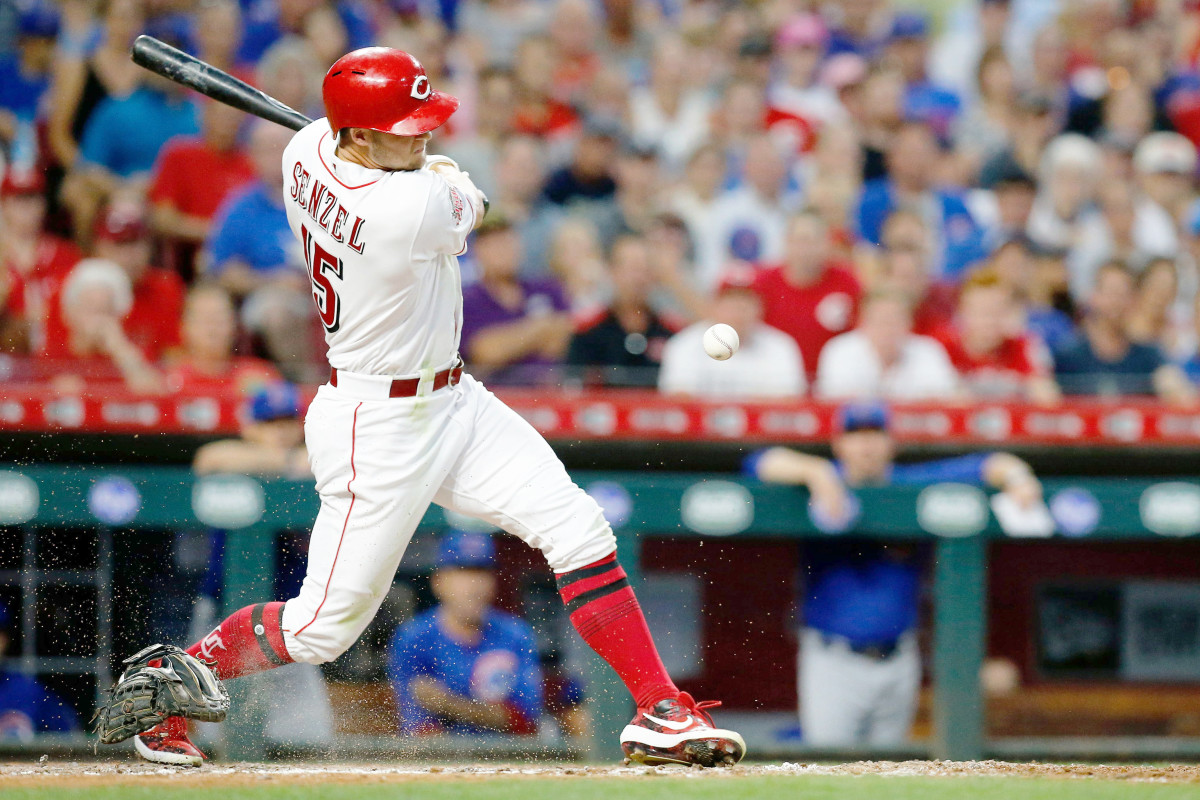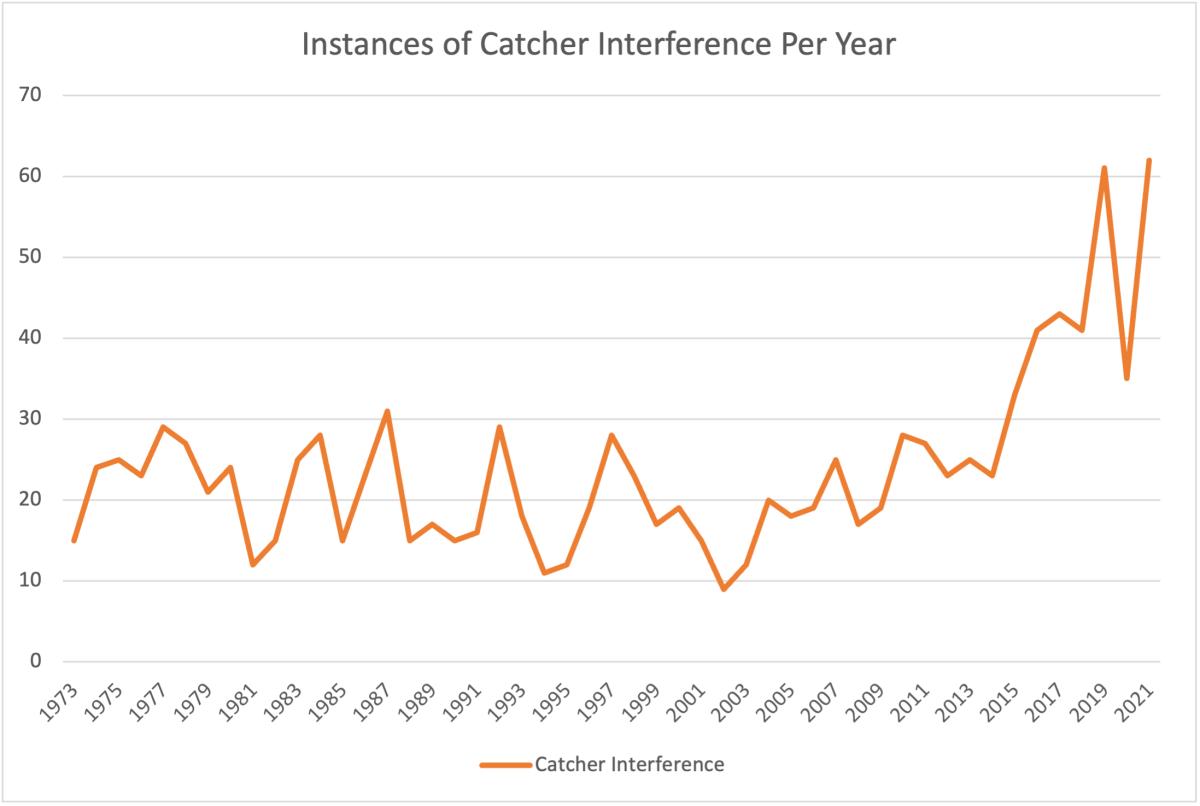Nick Senzel of the Reds Is the New King of Catcher Interference
Welcome to The Opener, where every weekday morning during the regular season you’ll get a fresh, topical story to start your day from one of SI.com’s MLB writers.
The catcher interference leaderboard offers two details of note.
First, most teams have yet to see a player reach base on catcher interference this year: This part is unremarkable, as it’s never been a terribly common play, and it’s not historically unusual for a club to go an entire season without experiencing it once. And second, “most teams” here is not a grouping that includes the Reds, because the Reds have Nick Senzel.
The Cincinnati center fielder has reached on catcher interference five times this season. Yes, 17 teams have not had any player do it once this year, and Senzel on his own has done it five times. That would be impressive on its own. But it’s more so in the context of his career, that of a pre-arbitration guy who has spent his time in the majors in search of better health and a starting job, an ordinary path in every way but one: Senzel appears to be likelier to reach base on catcher interference than perhaps any player in history.

Senzel’s involvement in five catcher interference calls this season brings his career total to 11 across four partial seasons. Perhaps that sounds low. But think of how relatively infrequent catcher interference is: To have reached base 11 times here puts him in exclusive company. And the fact that he’s done it so fast makes him stand alone. No one in baseball’s recorded history has reached on catcher interference so many times in so few plate appearances.
There are only 22 players who have reached base on catcher interference at least 11 times, according to Baseball Reference, which has partial data here going back to 1915, though it’s not guaranteed as complete until 1973. This means that out of thousands of players in the major leagues, many of them with careers stretching across thousands of plate appearances over years and years of games, there are fewer than two dozen who found 11 opportunities to go to first base on catcher interference. There are more guys who have hit 500 home runs than have reached 11 times on catcher interference! Which makes sense—again, this is not particularly common, with teams going full seasons without a single player doing it once. It’s not exactly skill-based, either, with little to suggest that getting catcher interference calls is anything that a hitter wants to dedicate time to cultivating while still, you know, trying to hit regularly. It’s rooted in luck just about as much as anything. There are of course some factors that are useful around the margins: It can help to have a particularly long swing, or a big follow-through, or to play in a division with a catcher especially prone to leaning in when there are runners on. It’s not total randomness. But mostly, it’s about being in the right place at the exact wrong time for the catcher, a very particular confluence of timing and fate that sends the batter to first base.
Which is all to say that, yes, career numbers are low here. It should not be too surprising that only a handful of players have crossed the threshold of double digits in a small, weird statistical department so heavily contingent on luck. And one of them is Nick Senzel—in just 200 career games and 766 plate appearances.
Perhaps you remember that reaching on catcher interference was something that happened particularly often for Jacoby Ellsbury. He retired as the all-time leader with 31. Do you know how long it took him to get to Senzel’s current total of 11? He needed 3,349 plate appearances. He’s followed on the leaderboard by Pete Rose, who took 5,650 plate appearances to reach 11, and then by Josh Reddick, who needed 3,192.
Senzel did it in 743.
That qualified as a record. Of the top 10 leaders in catcher interference calls, only one, Dale Berra, took fewer than 1,000 plate appearances to reach Senzel’s current mark of 11; Berra needed 807. Most of the others required twice as many chances, if not even more. What Senzel has done so far is unprecedented: No one has been involved in so much catcher interference with such relative few opportunities.
But one factor worth noting here? The general trend of more catcher interference in recent years is not limited to Senzel. Indeed, MLB appears to be in something of a golden age. While there’s always been a decent amount of variance in the number of interference calls from year to year, there’s been a clear upward trendline in the last few seasons, with new records set in this department in four of the last six seasons. Here are the league-wide numbers from the point where the data becomes more reliable in 1973:

If the 2020 decrease looks pronounced—remember that was less than half of a standard season! Yet even in just 60 games, there was so much catcher interference that it would have qualified as a record in any full season until 2015.
One obvious change is that catcher interference is now a call that can be subject to video review. (See: The heated talk that followed this interference review on Clayton Kershaw’s would-be strikeout of Jurickson Profar last April.) With the benefit of a second chance with cameras to catch even the slightest graze of bat against mitt, it’s only logical that umpires would be able to identify it more often. But that can’t be the only answer. The rules were updated to allow reviews of catcher interference only entering 2020—meaning the increase clearly predated it by a few years. Adding video review may have helped speed up the trend, in other words, but it didn’t cause it.
So what else? Part of it may be that catching has simply gotten harder in general. The position is now tasked with receiving harder, more varied stuff from more pitchers, all while their own defense has become quantified and more scrutinized. Teams have made framing pitches a greater priority in recent years now that they have the technology to quantify it and recognize the advantages of stealing strikes; one of the ways for catchers to make borderline pitches look like strikes is to reach for them just a little bit more and catch them before they leave the zone. This is particularly important on low pitches, as catchers start ever so slightly beneath the ball, come up to it as they receive it and hold it there, a process known as “sticking” the pitch. That’s tricky, and it might be part of the answer for the spike of interference. Pitchers are also throwing more off-speed and breaking pitches than ever before. To hit them, batters are forced to wait a split-second or two longer than they would against a fastball before beginning their swings, either because of the slower velocity or to read which way the pitch is breaking.
If it doesn’t feel quite right to say that this is a bona fide talent for Senzel, it doesn’t feel right to dismiss it entirely as luck, either. It’s at once too basic—too haphazard—to seem like a true skill, yet not quite random enough to feel like pure luck. But either way: Senzel just might be better at it than anyone baseball has ever seen.
More MLB Coverage:
• Back in My Father’s Day… These Are the Kids of the Boys of Summer
• Don’t Underestimate José Ramírez and Guardians
• The Four Key Factors Behind the Resurgent Braves
• Manny Machado Is Letting His Play Do the Talking
